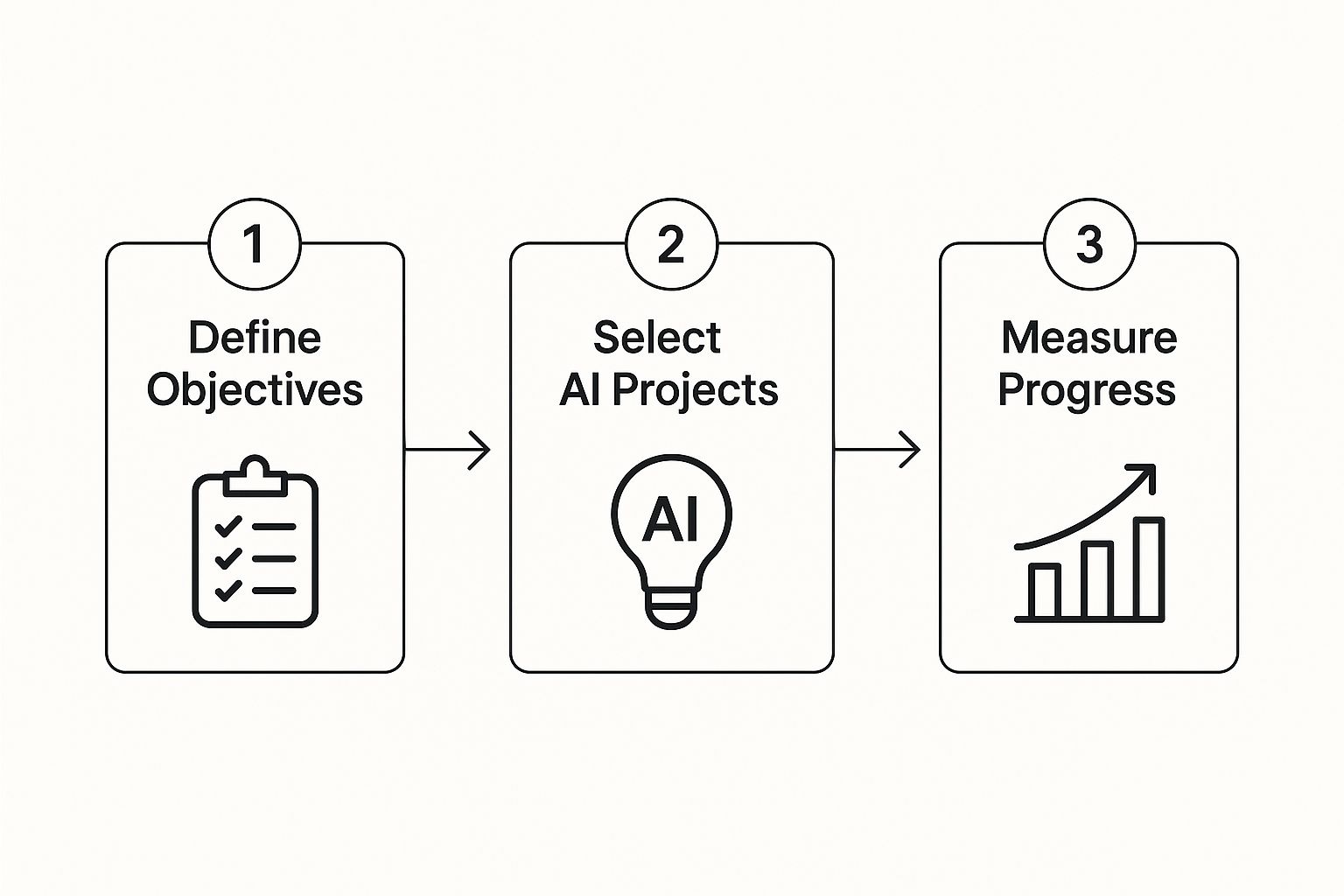AI Roadmap: Your Strategic Guide to Business Transformation
Build a winning AI roadmap with proven strategies from industry leaders. Get practical steps to overcome challenges and accelerate growth.

Why Your Business Needs an AI Roadmap Right Now
It’s easy to get caught up in the excitement around AI and grab the latest tool that promises to fix all your problems. But moving forward without a clear plan is a surefire way to waste time, money, and effort. An AI roadmap is more than just a document; it’s your strategic compass, guiding your business away from costly missteps and towards real, tangible value.
Think about it like this: you wouldn’t construct a new office building without a detailed blueprint. Yet, many businesses are diving into AI, a technology that can reshape entire operations, with little more than a vague idea. This often leads to pilot projects that fizzle out, tech that doesn’t sync with existing workflows, and teams that feel more overwhelmed than empowered.
Try this interactive AI strategy consulting tool that generates a tailored AI roadmap for your business needs.
The Real Cost of Skipping the Strategy Phase
I've had countless conversations with business leaders who share a similar story. They rushed to adopt an AI solution, only to get bogged down by unforeseen problems. One CTO I spoke with lamented a six-figure investment in an AI platform that, in the end, couldn't integrate with their legacy systems. This perfectly illustrates a crucial point: a solid AI roadmap forces you to take stock of where you are right now—your data quality, your tech stack, and your team's skills—before you spend a single euro.
Without this upfront thinking, you run the risk of:
- Wasted Investment: Pouring money into tools that are a poor fit for your actual day-to-day needs.
- Team Burnout: Expecting your people to adopt new systems without proper support or a clear "why" behind the change.
- Missed Opportunities: Focusing on flashy but low-impact AI gadgets while your competitors are strategically solving core business challenges.
Gaining Your Competitive Edge
A well-crafted AI roadmap turns this reactive scramble into a proactive strategy. It ensures that every AI project you start is directly tied to your most important business goals. This methodical approach is what separates companies that just play around with AI from those that achieve a genuine competitive advantage.
The market certainly isn't standing still. The AI sector is growing rapidly, with new applications constantly emerging. To help you see where the biggest opportunities lie, we've put together a table showing the projected growth across different AI technology sectors.
AI Technology Sector
Current Market Size
Projected Growth Rate
Business Applications
Machine Learning (ML)
~ €100 Billion
35% CAGR
Predictive analytics, demand forecasting, personalised marketing
Natural Language Processing (NLP)
~ €20 Billion
28% CAGR
Chatbots, sentiment analysis, automated report generation
Computer Vision
~ €15 Billion
25% CAGR
Quality control in manufacturing, retail analytics, security systems
Generative AI
~ €12 Billion
40% CAGR
Content creation, product design, code generation, drug discovery
Robotics & Automation
~ €80 Billion
20% CAGR
Warehouse logistics, automated manufacturing, customer service bots
Data compiled from various market research reports. CAGR (Compound Annual Growth Rate) projections are estimates through 2030.
As the table shows, areas like Generative AI and Machine Learning are not just growing; they're exploding. This growth signals that your competitors are already thinking strategically about how to deploy these technologies. In the Netherlands alone, the Artificial Intelligence market is projected to reach €2.38 billion in 2025 and is expected to climb to an impressive €9.64 billion by 2031. A roadmap ensures you're not just keeping pace, but setting the pace.
Ultimately, building an AI roadmap is about taking control. It’s about making deliberate, informed choices that build momentum, manage risks, and ensure that your investment in artificial intelligence delivers measurable, lasting results for your organisation.
Honest Assessment: Where You Stand and Where You're Going

Before you can map out a successful AI journey, you need a frank conversation about your starting point. It's easy to get caught up in the excitement of new AI tools, but a clear-eyed review of your organisation's current state is the bedrock of a solid plan. Without it, you're building a strategy on guesswork, not on facts. This isn't just a technical audit; it's a deep dive into your data, technology, and, most importantly, your people.
A recent survey highlights a significant gap: while 81% of organisations say they are experimenting with AI, only a tiny 4% have managed to roll it out across the entire business. This shows just how difficult it is to move from small tests to meaningful, company-wide use. The hurdles aren't always what you'd expect. While tech is part of it, issues like data privacy concerns (55%), a shortage of skilled staff (43%), and confusion about where to even apply AI (40%) are often what brings progress to a halt.
Auditing Your Core Capabilities
To build a roadmap that actually works, you need to look closely at three key areas. This isn't about creating a massive report that gathers dust; it's about gaining a genuine understanding of your strengths and weaknesses.
- Technology and Infrastructure: Can your current systems actually handle AI? I once worked with a logistics company keen to use a predictive maintenance tool for its fleet. A quick check showed their vehicle sensors were old and produced unreliable data. Spotting this early prevented a failed project and shifted their focus to upgrading data collection hardware first, a vital preliminary step.
- Data Quality and Governance: AI is only as smart as the data it learns from. Do you have clean, accessible, and well-governed data? Many companies find that only 45% have a formal data privacy policy in place. This isn't just about compliance; it's a fundamental block to using AI responsibly. Good AI depends on good data, which always starts with strong governance.
- Team Skills and Culture: Does your team have the know-how to use AI tools? Even more critical, is your company culture open to the changes AI will bring? The best AI model is useless if your team resists it or doesn't have the skills to make it work. Identifying these gaps early allows you to build training and change management into your plan from the start.
To help you get a clear picture of where you stand, we've put together an assessment framework. It’s designed to guide you through a structured evaluation of these core areas.
AI Readiness Assessment Framework
Comprehensive evaluation criteria for assessing your organisation's readiness across key dimensions of AI implementation
Assessment Area
Current State Indicators
Readiness Level
Next Steps
Technology & Infrastructure
- Legacy systems not integrated
- Limited cloud computing resources
- Lack of specialised AI/ML hardware
Low: Systems are a major bottleneck.
- Prioritise infrastructure modernisation
- Develop a cloud migration strategy
- Invest in a small-scale GPU cluster for testing
Data Quality & Governance
- Data is siloed in different departments
- No formal data quality checks
- Privacy policy is outdated or absent
Low: Foundational data issues will prevent AI success.
- Establish a data governance committee
- Implement a master data management (MDM) tool
- Conduct a data privacy audit and update policies
Team Skills & Culture
- Limited or no data science expertise in-house
- General resistance to new technologies
- No history of cross-departmental collaboration
Low: People and processes are not prepared for change.
- Launch an AI literacy and awareness programme
- Identify and upskill internal champions
- Plan for targeted hiring in key data roles
Strategic Alignment
- AI is seen as an IT project, not a business strategy
- No clear business problems identified for AI to solve
- Leadership buy-in is limited or inconsistent
Medium: Some awareness, but lacking a clear link to business value.
- Run workshops to connect AI capabilities to business goals
- Develop a formal business case for 1-2 pilot projects
- Secure a dedicated executive sponsor for the AI initiative
This framework should give you a realistic snapshot of your organisation. It moves you from vague ideas to specific actions, forming the basis for a practical and achievable roadmap.
From Assessment to Actionable Goals
Once you have this clear picture, you can set objectives that truly matter. The aim is to link every AI initiative directly to a business outcome, not just adopt technology for its own sake. Your assessment will help you pinpoint both quick wins and more ambitious long-term goals.
For example, the logistics company temporarily shelved its complex predictive maintenance project. Instead, they started with a smaller, more manageable AI initiative: optimising delivery routes using their existing (and cleaner) dispatch data. This quick win built momentum, showed tangible value, and secured support for their bigger plans down the line. This is how a great AI roadmap begins: with honesty, clarity, and a smart first step.
Crafting Your Custom AI Implementation Strategy
Once you have a clear-eyed view of your organisation’s current capabilities, it's time to turn that understanding into a solid plan. This is the moment your AI roadmap starts to become real, shifting from broad goals to a prioritised list of actions. A common pitfall is trying to mimic the AI strategy of a market leader. But what works for a huge company with deep pockets rarely fits a mid-sized business facing different challenges. Your strategy needs to be uniquely yours, built around your specific market position, resources, and pain points.
The heart of this process is prioritisation. Not every AI opportunity holds the same value. I've seen teams get incredibly excited about a technically impressive project that, when you boiled it down, offered very little actual business value. To sidestep this trap, successful organisations use a simple but powerful method: plotting potential AI projects on a matrix that weighs business impact against technical difficulty. This visual tool quickly separates the high-value, easy-to-implement "quick wins" from the more complex, long-term "strategic bets."
Phasing Your Initiatives for Sustainable Momentum
After you've prioritised your projects, the next task is to arrange them into logical phases. A "big-bang" approach, where you attempt to roll everything out at once, is a surefire way to overwhelm your teams and your budget. Instead, view your AI roadmap as a series of connected sprints, where each phase builds upon the successes of the one before. This phased method is essential for managing risk and keeping up momentum.
A fantastic example comes from a retail client I worked with. Their ultimate aim was a very advanced, AI-driven inventory management system. But they started much smaller:
- Phase 1 (Quick Win): They began by using a simple AI tool to analyse historical sales data, which improved demand forecasting for their top 20 products. This was a low-risk move that required minimal new tech and delivered a measurable drop in stockouts within three months.
- Phase 2 (Building Capability): Spurred by the success of the first phase, they got the green light for a bigger project. They used AI to optimise promotional pricing in one product category. This meant integrating more data sources and upskilling their marketing team.
- Phase 3 (Strategic Transformation): Finally, armed with experience and a proven return on investment, they tackled the full-scale, automated inventory system. By this stage, their teams were confident, their data infrastructure was more robust, and they had the complete backing of leadership.
This step-by-step progression creates a powerful feedback loop. Each success provides the fuel for the next project, making it easier to secure resources and manage what stakeholders expect.
Balancing Ambition with Practical Realities
A strong AI roadmap is both ambitious and achievable. It should push your organisation to grow without setting it up for failure. This means being brutally honest about timelines and who does what. If your top data scientist is already at full capacity, planning a project that demands 80% of their time is simply not realistic. Your roadmap must factor in these real-world limitations.
This visual process helps to make the path forward clear, showing the key stages from defining your main objectives to picking the right projects and, finally, measuring your progress.

The journey from defining objectives to measuring progress highlights that an AI roadmap is a continuous cycle, not a one-off task. A practical timeline also prepares everyone for the fact that AI implementation isn't always a smooth journey; building in buffers for unexpected delays is a sign of a mature, realistic strategy. By structuring your AI implementation in this way, you turn a huge undertaking into a manageable and motivating journey. You can explore how companies like yours are building their strategies with a platform like Ekipa AI, which helps turn these complex ideas into scalable results.
Mastering AI Regulations Without Killing Innovation

This is where many well-intentioned AI roadmaps hit a wall: underestimating the complex world of regulatory compliance. It’s easy to see regulations as a box-ticking chore to deal with later, but that’s a costly misstep. Smart organisations know that building compliance into their AI roadmap from the very beginning isn't a barrier. It's a strategic move that builds trust and speeds up adoption. Ignoring it can lead to derailed projects, big fines, and a damaged reputation.
The trick is to stop thinking of regulations as a list of restrictions and start seeing them as a guide for responsible progress. When your customers are confident you're handling their data and using AI with care, they trust you more. This trust becomes a real competitive advantage. The challenge, of course, is that the rules are always changing, which can feel like trying to hit a moving target.
Proactive Compliance: Turning Rules into an Advantage
Instead of waiting for regulators to come knocking, it’s far better to be proactive. This means embedding ethical and regulatory checks directly into your project development cycle. For instance, before your team writes a single line of code for a new AI tool, they should be asking some tough questions.
Here’s how to put this into practice:
- Data Provenance Audits: Where did the training data for this model originate? Is it biased? Do we actually have the right to use it? Answering these questions early on prevents major headaches down the line.
- Risk-Based Assessments: Not all AI tools carry the same level of risk. An internal chatbot for answering simple staff queries has a very different risk profile than an AI system used for credit scoring. Classify your projects to focus your compliance work where it counts the most.
- "Privacy by Design" Principles: Build privacy features into the core design of your AI systems from the start, not as an afterthought. This requires a fundamental shift in how you approach development.
Navigating the European Regulatory Landscape
For any business with operations in Europe, the regulatory scene is becoming clearer, and you need to keep these changes on your radar. In the Netherlands, the legal framework is closely tied to EU directives, particularly the groundbreaking EU AI Act. This legislation officially started on 1 August 2024, establishing the world's first complete legal framework for AI. While many of its main rules will take full effect after a two-year transition period around mid-2026, the time to prepare is now. It sets out specific requirements and even bans certain AI uses, meaning your roadmap must account for these rules. You can find more detail on how these trends are shaping up by reading expert legal guides that track the latest AI developments in the Netherlands.
By weaving regulatory awareness into your AI roadmap, you’re doing more than just avoiding penalties. You’re building more reliable, trustworthy, and ultimately more successful AI solutions. This proactive approach turns compliance from a burden into a powerful driver for sustainable growth and innovation.
Building AI Governance That Actually Works
An AI roadmap is more than a shopping list of exciting projects; it needs a solid governance framework to keep everything on track. For many, "governance" sounds like bureaucratic red tape designed to slow things down. But when done right, AI governance is the exact opposite. It creates clear guardrails that give your teams the freedom to innovate responsibly and quickly. It’s about building a system that fuels progress, sidesteps expensive mistakes, and makes sure every AI project reflects your organisation's values and legal duties.
Without this structure, accountability gets murky. Who's on the hook if an AI tool shows bias? Who approves the data it uses? A lack of clear roles and responsibilities breeds confusion, stalls projects, and can open the door to serious ethical or compliance issues. The aim is to create a system that spots potential problems early, long before they become costly, reputation-damaging crises.
Establishing Clear Roles and Accountability
Effective AI governance isn’t a one-department show. It's a team sport, involving people from all corners of the business. Picture it as a multi-layered defence system, where each layer has a specific job.
Here’s a practical setup many organisations are successfully using:
- AI Steering Committee: This is your high-level oversight group, usually made up of senior leaders from IT, legal, operations, and other key business areas. Their role isn't to get lost in the technical weeds but to ensure AI work aligns with the overall business strategy, manage major risks, and allocate resources. They handle the big-picture decisions.
- AI Review Board or Ethics Council: This group gets more granular. It includes subject-matter experts, data scientists, legal counsel, and privacy officers. They perform detailed reviews of proposed high-risk AI projects, checking for fairness, bias, transparency, and compliance. This is your main checkpoint for responsible AI development.
- Project-Level Roles: Within each AI project, you need well-defined roles. The Project Owner is accountable for the business case and its results, while the Technical Lead manages the development and data integrity. This embeds accountability directly into the day-to-day workflow.
Creating a Practical Review Process
Your review process needs to find a sweet spot between being thorough and staying nimble. A one-size-fits-all approach is a recipe for frustration—it will either be too heavy for simple projects or too light for complex ones. A better method is a risk-based system. An internal chatbot that summarises meeting notes doesn't require the same intense scrutiny as an AI model used for hiring decisions.
This tiered approach helps you direct your governance efforts where they matter most. Take the Netherlands, for example. The government is taking this very seriously. Prompted by recommendations from the Dutch Inspection of Digital Infrastructure (RDI), a new supervisory framework is being set up. With over 600 high-risk AI algorithms already registered nationally, all central government bodies must meet strict transparency and governance standards by the end of 2025. This reflects a wider trend: accountability is no longer optional. You can learn more about how the country is organising its AI supervision efforts on UNESCO’s website.
By creating a governance model with clear roles and a practical, risk-based review process, you aren’t slowing down your AI roadmap. You’re setting it on a firm foundation, allowing your organisation to move faster and with greater confidence toward real, meaningful progress.
Tracking Success and Evolving Your AI Roadmap
An AI roadmap isn’t a document you create once and then file away. Think of it as a living, breathing guide that needs to adapt based on your real-world results and the shifting ground of your market. To make it work, you have to look beyond just the technical details like model accuracy. Real success is measured by the tangible impact on your business. How can you be sure your AI projects are actually moving the needle?
The solution is to build a framework that measures what truly matters: business outcomes, user adoption, and operational efficiency. Without this, you're essentially flying blind, unable to justify future investment or explain the value of your work to sceptical stakeholders.
Defining Your Key Performance Indicators (KPIs)
Before you launch any AI project, you must define what success looks like in clear, measurable terms. If a marketing team is using an AI tool for customer segmentation, they shouldn't just track the algorithm’s precision. Instead, they should measure the uplift in campaign conversion rates or the increase in customer lifetime value.
Let's look at some practical examples for different business areas:
- Operations: For an AI-powered predictive maintenance system in a factory, don’t just track prediction accuracy. A better measure is the reduction in unplanned downtime by 15% or the 20% decrease in emergency repair costs.
- Sales: When using an AI tool to score leads, the main KPI isn't the number of leads scored. It’s the increase in the sales team's conversion rate from lead to close, or the reduction in time spent on unqualified prospects.
- Customer Support: A new chatbot's success isn't just about how many queries it handles. It’s about the 30% reduction in human agent workload for repetitive questions, the improvement in customer satisfaction (CSAT) scores, or the drop in average response time.
These kinds of KPIs tie every AI project directly back to business value, which makes communicating its success much simpler.
Building Feedback Loops for Continuous Improvement
Your AI roadmap must also be agile enough to evolve. Markets change, new technologies appear, and an idea that seemed brilliant six months ago might be obsolete today. This is where building formal feedback loops becomes critical.
This isn't just about an annual review. It’s about creating a continuous cycle of learning and adapting. Set up regular check-ins—quarterly is often a good rhythm—with your AI steering committee and project teams. During these meetings, you should review progress against your KPIs, talk about unexpected challenges, and, most importantly, decide when to pivot.
Sometimes, a pivot means reallocating resources from a project that's not performing well to one that shows more promise. Other times, it might mean stopping a project entirely, a tough but necessary decision to avoid wasting resources. A strong governance process ensures these decisions are based on data, not politics. This iterative approach, 'measure, learn, adapt', is what turns a static document into a powerful strategic tool, ensuring your AI roadmap continues to deliver real value as your organisation and the world around it changes.
Your AI Roadmap Action Plan
After months of assessing your business and careful strategic planning, it's time to bring your AI roadmap to life. This is where all those insights turn into real, tangible actions. To keep things moving and prevent the initial excitement from fizzling out, it helps to break the journey into a manageable 30-60-90 day plan. This approach turns a massive transformation into a series of achievable steps, keeping your team focused and motivated.
First 30 Days: Secure Backing and Build Your Core Team
Your first month is all about setting the foundation and getting everyone on the same page. The main goal isn't to launch a huge, complex project, but to get the initiative off the ground formally. This begins with securing genuine stakeholder buy-in. You need more than just a nod of approval; you need active champions for the cause. Use the data from your readiness assessment and your list of prioritised projects to build a compelling business case for leadership. Zero in on a single, high-impact pilot project that can deliver a quick, measurable win.
At the same time, you need to assemble your core AI team. This is not just a job for the IT department. A well-rounded team should include:
- An Executive Sponsor from the leadership team who can advocate for the project.
- A Project Lead to oversee the day-to-day work and keep things on track.
- Representatives from the business unit that will be most affected by the pilot project.
- A data expert who knows your company's data inside and out.
Next 60 Days: Launch Your First Pilot Project
With your team assembled and support secured, the next two months are all about action. The objective is to launch your first pilot project and achieve a concrete success. This is a critical learning period. It’s wise to pick a project with a high chance of success, like automating a repetitive internal task or using AI to pull initial insights from a clean dataset. For example, a marketing team could use an AI tool to analyse customer survey feedback to spot key themes, rather than attempting to build a complex predictive churn model right out of the gate.
During this time, keep the lines of communication wide open. Hold weekly check-ins to talk about what’s going well, tackle any roadblocks, and celebrate the small victories. These early wins are vital for keeping morale high and showing the practical value of your AI roadmap to the rest of the company.
The 90-Day Mark: Analyse Results and Plan for What's Next
This final block of your initial plan is for reflection and future planning. Once your pilot project is complete, it's time to conduct a thorough review. Ask yourselves:
- Did we meet our predefined KPIs?
- What unexpected challenges did we face?
- What did the team learn from the process?
The answers to these questions will provide invaluable information for refining your wider AI roadmap. Use the success of the pilot to build a strong case for the next phase. This could mean scaling up the initial project or taking on a slightly more ambitious initiative. This cycle of executing, learning, and adjusting is the engine that will drive lasting AI success in your organisation.
Ready to turn your plan into reality? The Ekipa AI offers AI strategy consulting help by co-creating your AI ideas after thoroughly analysing it backed with expert insights. It further helps you move from strategy to scalable impact, providing the tools and expertise to execute your roadmap effectively. Book a free consultation to get the help you need.



